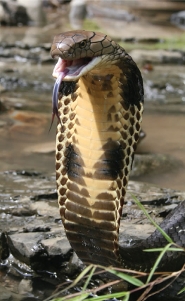
Mysteries in snake venom evolution
A new analysis of the king cobra genome by Michael Richardson, Christian Henkel (IBL) and collaborators at the IBL and Naturalis, Helsinki and Singapore has been published in "Toxins”. The analysis suggests a possible answer to one of the tantalising mysteries in snake venom evolution: why do snakes sometimes have multiple copies of the same toxin gene in their venom?

photo credit: Freek Vonk
In the king cobra genome, for example, there are 21 copies of one toxin gene called a 'three-finger toxin' and each one is slightly different. One possibility is that having many slightly different toxins, might provide broad spectrum toxicity against a range of prey species. This might be advantage to snakes that have a 'generalist' diet, eating any prey species that they come across. If each toxin is tuned to a slightly different species, that would make sense. However, the king cobra is a specialist not a generalist: it only eats other snakes. So, another reason for having multiple copies of a toxin, each slightly different, is that it could multiply the power of the venom, an effect called 'potentiation'. This means that having a cocktail of slightly different toxins is more lethal than having only one toxin. However, the solution proposed by Richardson, Henkel and colleagues is more simple.
Mystery solved?
Richardson, Henkel and colleagues found that the three finger toxins that became duplicated most recently in evolution, tend also to be present in multiple copies. Furthermore, the presence of multiple copies tend to be more highly expressed in the venom. In other words, duplicating the toxin gene means it gets to be delivered in a larger quantity in the venom.
Link to the article: Snake Genome Sequencing: Results and Future Prospects.
